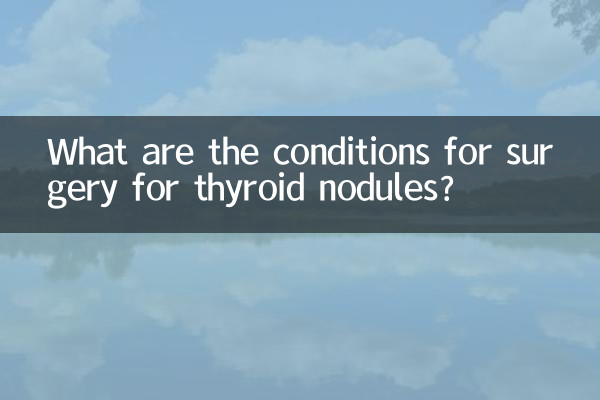When do thyroid nodules require surgery?
Thyroid nodules are abnormal masses that form within the thyroid tissue. Most are benign, but some cases require surgical intervention. This article will combine the hot topics and hot content on the Internet in the past 10 days to provide you with a detailed analysis of the indications, risks and postoperative care of thyroid nodule surgery.
1. Indications for thyroid nodule surgery

According to clinical guidelines, surgical treatment is usually recommended for thyroid nodules in the following conditions:
| Indications | Specific instructions |
|---|---|
| Malignant or suspected malignant | A needle biopsy confirms cancer, or ultrasound shows high-risk features (such as microcalcifications, irregular edges) |
| Symptoms of compression due to large nodules | Diameter >4cm may cause difficulty breathing, difficulty swallowing, and hoarseness |
| Hyperthyroidism cannot be controlled | Toxic nodules lead to hyperthyroidism that cannot be corrected by drugs |
| rapid growth | Volume increase >50% or diameter increase >20% within 6 months |
| Aesthetic needs | The obvious bulge in the neck affects the appearance and the patient strongly requests it. |
2. Comparison of surgical methods
| Surgery type | Excision range | Applicable situations | Advantages | Disadvantages |
|---|---|---|---|---|
| hemithyroidectomy | Unilateral thyroid lobe | Unilateral benign large nodule | Preserve some thyroid function | Possible recurrence on the opposite side |
| total thyroidectomy | All thyroid tissue | malignant or bilateral disease | Completely remove lesions | Need to take thyroxine for life |
| radiofrequency ablation | local nodular tissue | small size benign nodule | Minimally invasive and scar-free | Not suitable for malignant lesions |
3. Surgical risks and complications
Although thyroid surgery technology is mature, there are still certain risks:
1.Recurrent laryngeal nerve injury(Incidence 1-2%): May cause hoarseness or even loss of voice
2.hypoparathyroidism: Temporary incidence rate is about 15-30%, permanent rate is about 1-3%
3.postoperative bleeding: The incidence rate is <1%, but it may compress the trachea and cause suffocation.
4.hypothyroidism: Total resection occurs in 100% of patients and requires lifelong replacement therapy
4. Key points of postoperative care
| time stage | Nursing focus |
|---|---|
| 24 hours after surgery | Monitor breathing/bleeding and maintain semi-recumbent position |
| 1 week after discharge | Wound care (avoid getting wet), review blood calcium |
| 1 month after surgery | Adjust thyroxine dose and review thyroid function |
| long term follow up | Ultrasound every 6-12 months to monitor for recurrence |
5. Latest research progress (hot spots in the past 10 days)
1.AI-assisted diagnosis: The latest research in the "Nature" sub-journal shows that the deep learning model has an accuracy of 92% in judging the benign and malignant thyroid nodules, which is better than traditional ultrasound examination.
2.Intraoperative neuromonitoring: Domestic tertiary hospitals have promoted real-time recurrent laryngeal nerve monitoring technology to reduce the nerve injury rate to less than 0.5%.
3.day surgery model: Eligible simple thyroid surgeries can now complete the entire admission-surgery-discharge process within 24 hours.
Summarize: Whether thyroid nodules require surgery requires a comprehensive evaluation of benign and malignant, size, symptoms and patient wishes. As medical technology advances, surgical safety and accuracy continue to improve. It is recommended that patients bring complete examination data (including ultrasound and puncture results) to a specialist clinic for individualized evaluation.

check the details

check the details